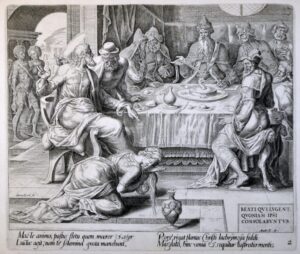In Saint Luke’s account in the Bible, a ‘sinful’ woman washed the feet of Christ with her tears at a banquet in the House of Simon, one of the Pharisees. A forgiven sinner, this woman is shown kneeling in humility as she lifts her flowing hair to dry Christ’s feet. At various points in history, this woman has been associated with Mary Magdalene, who is referred to earlier in Luke’s gospel (Luke 8:1-3). This association is contested by biblical scholarship, however it has inspired many works of art. Van Heemskerck splendidly adorned the composition with ornament, including the ointment jar in the foreground and elaborate fabrics throughout. This didactic scene is one of around 600 drawings van Heemskerck produced for engraving.
Maarten van Heemskerck (Heemskerck 1498-1574 Haarlem) Magdalen washing the feet of Christ in the House of Simon 1566 Pen and brown ink, over traces of black chalk, incised for transfer 205x255mm Samuel Courtauld Trust: Witt Bequest, D.1952.RW.1954


In the engraving, Van Heemskerck’s drawn composition is shown in reverse as is typical in printmaking. The scene is staged in a space evocative of ancient Rome. In the distance we see the Pantheon. Juxtaposing Christian narrative with overtly pagan Roman imagery, Van Heemskerck historicizes the biblical story and also recalls his own experience as a young artist, drawing the antiquities of Rome when he travelled there in the 1530s.
The drawing depicts a group of figures seated at a table and witnessing the act of Mary Magdalene washing the feet of Christ in the House of Simon the Pharisee as described in Luke 7:36-50. According to the Gospel account, Mary Magdalene, a woman who had lived a sinful life, came to the banquet and began to weep, her tears falling onto Jesus’ feet, which she then wiped with her hair, kissed, and perfumed with ointment from a jar. Simon was shocked that Jesus would allow an impure woman to do this. Yet Jesus, invoking a parable about the forgiveness of debts, explains that through her great faith, demonstrated by her love for Jesus, her sins have been forgiven.
Heemskerck has displaced Jesus from the privileged centre of the composition, forming a pictorial divide between the fancifully dressed Parhisees at the table who directly witness and discuss what is taking place before them, and two men in humbler attire outside the banquet who look on in amazement. Pointing at the Magdalene with his right hand while reaching up with his left, Jesus extolls her behaviour as a virtue. Her flowing garments echo the flow of her hair and emphasize her place between the Jesus and the beholder, mediating between the world of sin and the sacred.
While the banquet described in the Bible took place in Jerusalem, Van Heemskerck relocated it to Rome. In the distance at right, we glimpse the Pantheon, the ancient temple dedicated to all gods yet later repurposed as a Christian church. Van Heemskerck appears to suggest a parallel between Mary Magdalene’s conversion from sin to true faith in Jesus and the conversion of Rome from the capitol of a pagan empire to the epicentre of Western Christianity. In doing so, he also invests the image with his own artistic identity. Van Heemskerck staked his reputation on his knowledge of antiquity and his highly mannered style, which he forged in large measure during his formative years of study in Rome in the 1530s, when he produced famous drawings of monuments including the Coliseum and the Pantheon.[1]
The drawing contains slight traces of preliminary under-drawing surrounding the figure of Christ Jesus and the Magdalene, revealing that the artist planned the composition carefully before beginning to draw with the pen. Later, the sheet was prepared for engraving. Accordingly, dominant lines of the Courtauld work were finely indented with a stylus, enabling the transfer of the design to the copperplate.
Heemskerck produced around 600 drawings from which engravings were made, and he often recycled figures in these designs.[2] In the same year Heemskerck completed this drawing, the engraver Herman Muller issued a print of Tamar giving Birth to Pharez and Zarah, also after Heemskerck’s design, in which the midwives assume poses remarkably close to that of the Magdalene in this print.[3]
The emotive force of this figural type drove an unusual transformation in the history of the engraving based on the Courtauld drawing. The printmaker Muller re-issued it as part of the second in a series of the ‘Eight Beatitudes’ in the Theatrum Biblicum of 1674 and introduced significant changes. The bowl and ewer occupying were replaced by a quotation from Matthew 5:4: ‘Blessed are those who mourn for they shall be comforted’. By adding this inscription to the print, Muller superimposed a new interpretation on the image, shifting the focus from the Magdalene’s gesture of personal conversion to a more universal theme of consoling the bereaved. If this alteration gave the image new currency, it also suggests the flexible nature of Heemskerk’s singular fusion of classical form and Christian content.
HW
Footnotes
Bibliography
DIFURIA, 2009
Arthur DiFuria, ‘Remembering the Eternal in 1553 Marten van Heemskerck’s Self-Portrait before the Colosseum’, Envisioning the artist in the early modern Netherlands, Nederlands Kunsthistorisch Jaarboek, vol. 59, 2009, 91-103.
LONDON, 2012
Colin Bailey and Stephanie Buck (eds.), Master Drawings from the Courtauld Gallery, London, 2012.
VELDMAN 1993
Ilja Veldman, The New Hollstein Dutch & Flemish Etchings, Engravings and Woodcuts 1450-1700, Ger Luijten (ed.), 2 vols., Roosendaal, 1993.
WHITAKER 2011
Lucy Whitaker and Kate Heard, The Northern Renaissance, Dürer to Holbein, London, 2011.





